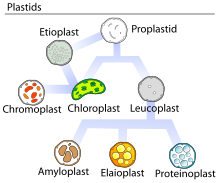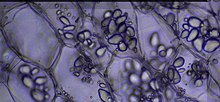Proteinoplast


Proteinoplasts (sometimes called proteoplasts, aleuroplasts, and aleuronaplasts) are specialized organelles found only in plant cells. Proteinoplasts belong to a broad category of organelles known as plastids. Plastids are specialized double-membrane organelles found in plant cells.[1][2] Plastids perform a variety of functions such as metabolism of energy, and biological reactions.[2][3] There are multiple types of plastids recognized including Leucoplasts, Chromoplasts, and Chloroplasts.[2] Plastids are broken up into different categories based on characteristics such as size, function and physical traits.[2] Chromoplasts help to synthesize and store large amounts of carotenoids.[4] Chloroplasts are photosynthesizing structures that help to make light energy for the plant.[4] Leucoplasts are a colorless type of plastid which means that no photosynthesis occurs here.[3] The colorless pigmentation of the leucoplast is due to not containing the structural components of thylakoids unlike what is found in chloroplasts and chromoplasts that gives them their pigmentation.[4] From leucoplasts stems the subtype, proteinoplasts, which contain proteins for storage. They contain crystalline bodies of protein and can be the sites of enzyme activity involving those proteins. Proteinoplasts are found in many seeds, such as brazil nuts, peanuts and pulses. Although all plastids contain high concentrations of protein, proteinoplasts were identified in the 1960s and 1970s as having large protein inclusions that are visible with both light microscopes and electron microscopes. Other subtypes of Leucoplasts include amyloplast, and elaioplasts. Amyloplasts help to store and synthesize starch molecules found in plants, while elaioplasts synthesize and store lipids in plant cells.[1]
See also
[edit]References
[edit]- ^ a b Dey PM, Brownleader MD, Harborne JB (1997-01-01). "Chapter 1: The Plant, the Cell and its Molecular Components". In Dey PM, Harborne JB (eds.). Plant Biochemistry. London: Academic Press. pp. 1–47. ISBN 978-0-12-214674-9.
- ^ a b c d Grabsztunowicz M, Rokka A, Farooq I, Aro EM, Mulo P (September 2020). "Gel-based proteomic map of Arabidopsis thaliana root plastids and mitochondria". BMC Plant Biology. 20 (1): 413. doi:10.1186/s12870-020-02635-6. PMC 7650296. PMID 32887556.
- ^ a b Pinard D, Mizrachi E (April 2018). "Unsung and understudied: plastids involved in secondary growth". Current Opinion in Plant Biology. 42 Genome studies and molecular genetics 2018. 42: 30–36. doi:10.1016/j.pbi.2018.01.011. PMID 29459221.
- ^ a b c Sadali NM, Sowden RG, Ling Q, Jarvis RP (July 2019). "Differentiation of chromoplasts and other plastids in plants". Plant Cell Reports. 38 (7): 803–818. doi:10.1007/s00299-019-02420-2. PMC 6584231. PMID 31079194.
